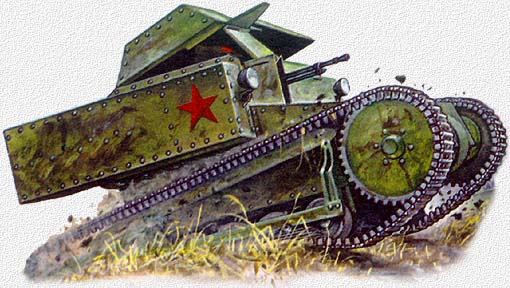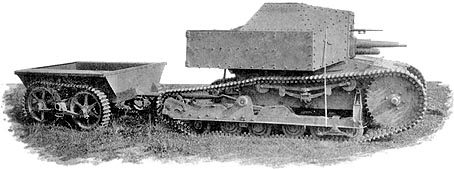| The T-27 Armored Tankette |
|---|
|
|

| The T-27 Armored Tankette |
|---|
|
|

During World War One, there was already a need for fast and maneuverable tanks to exploit the success of the infantry and to support cavalry to enter the rear of the enemy. The first light tanks were the French Renault FT-17 and the British Mk A. There was also a need for small super-light tanks for reconnaissance: the tankette.
One of the first tankettes was developed by Englishman Major J. Martel. In his own repair shop, he constructed his tankette from spare parts and elements of common cars. It was a single-seat vehicle with very light armor protection, and was armed with one machine-gun. In trials, the tankette achieved a speed of 24 km/h. Almost simultaneously, a small single-seat tankette was developed by another Englishman, engineer J. Carden, in which the driver was in a prone position. The first tankettes were full of various defects and imperfections and none of them were put into mass production. Taking into account the defects of the first tankettes, engineers started working on two-seater vehicles, which were ready by 1927. The two-seater variant was chosen because engineers doubted that one person would be able to act as driver, machine-gunner, and observer simultaneously. The most successful tankette was a two-seater that went through numerous modifications and improvements and was finally accepted for service in 1929 under the "Mk IV Carden-Loyd" designation. It was manufactured by Vickers-Armstrong. The tankette was quite popular, and it was sold to sixteen countries all over the world, including Poland, Italy, Czechoslovakia, France, Japan, Canada, Belgium and Egypt. By the mid 1920's, France paid little attention to the development of light tankettes. However, the obvious success of the English attracted their attention and compelled French engineers to start their own work on tankettes. In 1929, they developed the single-seated tankette called the "Sabat." This vehicle was intended to be transported by a truck, and in battle it ran on its tracks. The tankette was operated by a driver who was in the prone position. During a non-combat situation, the driver could operate the tankette in a sitting posture. France received a license to manufacture the Carden-Loyd, and this defined the future development of French tankettes. For example, in 1933, the "supply tank" Renault UE was developed, and later it was converted to a common tankette. |
Italy received a license for the Mk IV as well, and then manufactured it under the designation C.V.29 where the "29" stood for the year it was accepted for service. These vehicles were used quite intensively during the Spanish Civil War. Poland developed its own reconnaissance tank TK-3 (1931) and then the TKS (1934) which were copied from the original Carden-Loyd. The Czech developed and manufactured the MU-4 tankette. In Russia, the very first tankette project was independently developed in 1919 by the Russian engineer I. Maksimov. The tankette was named "Sh'itonoska" which meant "Shield Carrier." The vehicle was armed with one machine-gun and was operated by a single crewman who was in the prone position. |
By the end of the 1920's, new rules and regulations for the Red Army were introduced. The regulations defined the future development of the domestic armored fighting vehicles, and in particular they stipulated the "development and manufacture of a small reconnaissance tank" that was intended for co-operation with the MS-1 tanks as well as for reconnaissance and for communication purposes. In the period of 1927 to 1930, the Design Bureau of the VOAO ("Vsesouznoe Orudijno-Arsenal'noe Ob'edinenie" - "All-Union Arsenal Association") designed several tankettes based on the chassis of the T-16 light tank: the T-17, the T-21 (only a paper project), the T-23, and the T-25 (paper project). The T-23 was designed in two variants: one with a turret, and the other turretless. The T-25 was a modernized variant of the T-17 tankette. |

All of these vehicles were quite good for the time, although they had many flaws. These defects would have taken a lot of time to correct, and because of this, the idea came up to buy a license for the Carden-Loyd Mk IV. In 1930, the Soviet Union bought the first batch of 26 original Carden-Loyd tankettes from Britain. In the Soviet Union, these vehicles were re-named the 25-V (some archive documents name them the K-25). Also, the Soviet Union bought a license to mass produce these vehicles. According to the production plan, in 1930 to 1931, 290 tankettes had to be manufactured, and after that 400 tankettes per year. The manufacture was set up in the Autozavod #2 VATO in Moscow (in 1932, this factory was renamed to Factory #37). |
However, Soviet engineers weren't fully satisfied with the original Carden-Loyd tankette and before its mass production they significantly modernised it (the Chief Engineer was N. Kozyrev, and the Lead Engineer was K. Sirken). The hull's dimensions were increased, the running gear was improved, and the machine-gun mount was modified for the installation of a DT machine-gun. Some other improvements were made to take into account the USSR's geographic and climatic conditions and the Russian mindset. |
Due to the modernisation, the new tankette was significantly changed from the British original, and that is why on February 13, 1931, it was accepted for service under the "T-27" designation. The T-27 was manufactured simultaneously in two factories: the Bolshevik factory in Leningrad, and the newly-built automobile factory in Nizhnij Novgorod (later it was named GAZ). The hull of the T-27 was assembled of rolled-armor plates which were fastened by rivets and partially welded. On the roof there were two squared hatches. All joints of the armor plates were pressurised by canvas gaskets to increase the fording depth of the T-27. The tankette was armed with one 7.62 mm DT Machine-Gun Model 1929. The T-27 didn't have any internal and external communication devices, as communication between vehicles was supposed to be conducted through signal flags, which was typical for Soviet tanks of that time. |
The vehicle was powered by the GAZ-AA water-cooled four-cylinder gasoline engine (copied from the Ford-AA) rated at 40 h.p at 220 rpm. The crew consisted of two men: the commander/machine-gunner and the driver. The tankette was used for reconnaissance by mechanized forces of the Red Army. Until the end of 1932, 65 tankette battalions were formed, with about 50 tankettes per battalion. In the future, the number of those battalions was restricted to 23. At the inception of the Red Army's mechanised forces, the T-27 tankettes played a very important role, but later on, this role was reduced due to the development of more modern vehicles. By January 1, 1937, 2,547 T-27s remained in service. In the beginning of the 1930's, T-27s were successfully used in Central Asia (in the Kara Kum Desert in particular) to combat the Basmach (the name for any anti-Bolshevik Asiatic natives). By the end of the 1930's, the T-27 was removed from Red Army front-line service, and thereafter used for training purposes. In addition, some tankettes were sent to the OSOAVIAKhIM (The Association for Assistance of Defense, Aircraft and Chemical Development). After some improvements, T-27s were used for towing battalion field guns (37-mm and 45-mm calibres). |

By January 1, 1941, 2,157 T-27 tankettes remained in service, and some of them took part in the initial stages of the Great Patriotic War. The last mentioned combat use of T-27s was during the Battle for Moscow (winter 1941-42): on December 1, 1941, some T-27 tankettes supported the attack of the 71st Independent Marine Brigade in the Yakhroma area.

The army found that the T-27 was very simple and undemanding in operation. However, due to its narrow tracks, the tankette wasn't effective in swamps and snowy terrain. The dimensions of the T-27 were so small that only shorter men could get in it. Moreover, experience showed that the lack of a traversing turret and an ability to swim across rivers was a hinderance. Later, these features were realised in the T-37 and the T-38 light tanks. The Soviets tried to enlarge the tactical abilities of the T-27. For example, in 1933, a small batch of self-propelled 37-mm Hochkiss guns was manufactured by the Bolshevik factory in Leningrad. These SP guns were based on the chassis of the T-27. Some of those vehicles were additionally armed with the DT machine-gun. Because the vehicle was very small, the ammunition load was located separately in the tracked trailer that was towed behind the vehicle. In 1932, one T-27 was rearmed with a flamethrower (the flamethrower had a range of 25 metres). This vehicle was tested in 1932, and in 1935 a batch of 164 flamethrower tankettes was produced. Combat records for these vehicles are not yet available. |
In 1933 to 1934, the Special Design Bureau of the Krasniy Putilovetz factory designed a self-propelled gun in which the 76.2 mm KT gun was mounted on the T-27's chassis. The gun was carried by one vehicle, and the crew and ammunition were transported in a second vehicle. The project and five experimental vehicles were intended for support of Red Army motorised troops. The gun was either mounted in the open or was protected by an armored shield (like common field guns). However, the chassis was overloaded, and the new vehicle was unable to run off-road because its engine quickly overheated. Further work was cancelled. |
In 1933, a self-propelled gun armed with Kurchevsky's 76-mm recoilless gun was developed. The vehicle successfully passed all tests on the proving ground and was sent to the army's trials which it failed because of the poor ballistics of the gun. The gun was also unstable when it fired and it was unsafe to operate. Grokhovsky's Design Bureau also developed a tankette armed with two unguided missiles. These missiles were located on both sides of the hull. Several T-27s were pressurised and supplied with special equipment for underwater river crossings. |
In March of 1930, ordered by M. N. Tukhachevsky, the first motorised airborne forces were formed. Initially, the troops were equipped with MS-1 light tanks, but later on they were replaced with T-27 tankettes. The troops consisted of four battalions. By 1933, each battalion included one company of T-27 tankettes. In 1935, T-27's were transported by TB-1 and TB-3 bombers during military manoeuvers. The tankettes were suspended under the planes by a special mechanism developed by engineer A. F. Kravtzev. |

| REFERENCES: Blueprint of the Italian C.V.29 Blueprint of the Soviet T-27 Specification of Soviet tanks Specifications of Soviet tank guns The Glossary of Soviet Terms and Abbreviations |
Proof-reader:
Mark Jaremco Sources: Bronekollektsiya #1, 1998; V.N.Shnurkov "Weapons of the Red Army", Minsk, 1999; MOdelist-Konstruktor #9, 1991; "Light tanks and armored cars of the Red Army", Moscow, 1996; "Tanks", Smolensk, 2000; Bruno Benvenuti "Carri Amati" vol.1, Roma |